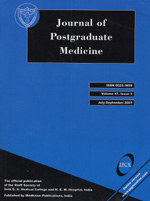
|
Journal of Postgraduate Medicine
Medknow Publications and Staff Society of Seth GS Medical College and KEM Hospital, Mumbai, India
ISSN: 0022-3859
EISSN: 0022-3859
Vol. 49, No. 4, 2003, pp. 311-315
|
 Bioline Code: jp03087
Bioline Code: jp03087
Full paper language: English
Document type: Research Article
Document available free of charge
|
|
|
Journal of Postgraduate Medicine, Vol. 49, No. 4, 2003, pp. 311-315
| en |
The Effect of use of Pyridostigmine and Requirement of Vecuronium in Patients with Myasthenia Gravis
Tripathi M, Kaushik S, Dubey P
Abstract
CONTEXT: Patients with myasthenia gravis receive pyridostigmine, an anticholinesterase
agent, as a part of therapy. These patients demonstrate a heightened sensitivity
towards non-depolarising muscle relaxants. Continuing pyridostigmine till the
day of the surgery or omitting it on the night before surgery could provide variable
results with regards to the effect of vecuronium.
AIMS: Myographic evaluation
of a dose of vecuronium in patients with myasthenia gravis on pyridostigmine
therapy.
SETTING AND DESIGN: A randomised, double-blind, clinical study conducted
in a teaching hospital.
SUBJECTS AND METHODS: Medically (oral pyridostigmine)
well-controlled adult patients with myasthenia gravis who were posted for thymectomy,
were randomly divided into two groups. Patients in Group 1 received their last
dose of pyridostigmine on the night before surgery while those in Group 2 received
even the morning dose of the drug on the day of surgery. Neostigmine (1-2 mg)
intravenously was used as rescue medication. Vecuronium (0.01mg/kg) was used
for intubation and muscle relaxation during trans-sternal thymectomy and its
effect was reversed using neostigmine and atropine.
RESULTS: Fourteen patients
(7 in each group) belonging to both sexes were enrolled in the study. The intubating
dose of vecuronium showed quicker onset time (155 sec or 2.7min approx.) and
peak effect (99% T1 suppression) in patients belonging to Group 1, and 3/7 (43%)
complained of respiratory discomfort while waiting for surgery. By giving the
morning dose of pyridostigmine (Group 2), an identical intubating dose of vecuronium
showed relative resistance (peak effect-97% T1 suppression) and delayed onset
time (198 sec approx.). However, the reversal was complete at the end of surgery
in both the regimens.
CONCLUSIONS: Omission of the pyridostigmine dose on the
day of surgery predisposed patients with myasthenia gravis to the possibility
of respiratory discomfort and sensitivity to vecuronium. Continued administration
significantly prolonged the onset time of vecuronium and the patients required
a higher dose of vecuronium.
Myasthenia gravis is an autoimmune disease, characterised by muscle weakness.
It is related to the reduction in the functional acetylcholine (Ach) receptor
population at the neuromuscular junction due to the presence of Ach-receptor
antibodies. These patients have a variable response to muscle relaxants and are
very sensitive towards non-depolarising muscle relaxants. It has been reported
that vecuronium bromide in reduced doses is safe and effective and that larger
the preoperative pyridostigmine dose, greater is the patient's sensitivity to
the non-depolarizing agents.[1] It has also been
suggested that the sensitivity to vecuronium in patients with myasthenia gravis
may be influenced by the anti-cholinesterase therapy.[2],[3] The continued use of anti-cholinesterase therapy prior to thymectomy in patients with myasthenia gravis has been a matter of ongoing debate. The aim of this prospective clinical study was to compare the effect of two different regimens of pyridostigmine in patients with myasthenia gravis undergoing thymectomy under balanced general anaesthesia.
Keywords
Vecuronium, Myasthenia gravis, Pyridostigmine, Non-depolarising block.
|
| |
© Copyright 2002 Journal of Postgraduate Medicine. Online full text also at http://www.jpgmonline.com
Alternative site location: http://www.jpgmonline.com
|
|
